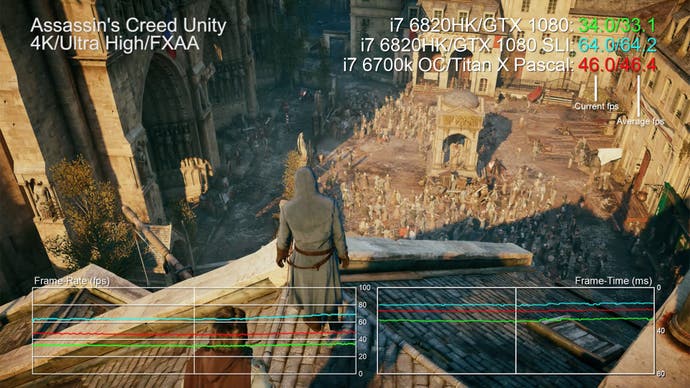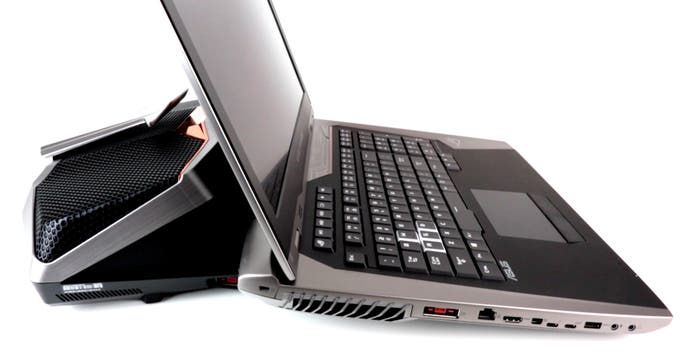Asus ROG GX800VH review - the world's most powerful gaming laptop?
Liquid-cooled overclocked i7 meets twin GTX 1080s, powering a 4K screen. Is it faster than a Titan X desktop?
Asus reckons that the ROG GX800VH could well be the most powerful consumer-level laptop in the world - and I it may well be right. The spec on this gaming laptop monster borders on the insane. An overclockable mobile Intel i7 K chip is paired with twin GTX 1080s in SLI, which works in combination with an 18.4-inch 60Hz 4K display. As long as the game in question is reasonably optimised for SLI, the bottom line is this - the GX800VH offers even more gaming power than a desktop i7 system paired with an overclocked Titan X Pascal. Other dual 1080 gaming laptops are available to challenge the Asus's crown - but to the best of my knowledge, none of them come with a liquid cooling dock to guarantee performance and stability. And yes, you can overclock it too.
The GX800VH has a premium finish virtually everywhere you care to look. Our review sample came with a ludicrous 64GB of 2400MHz DDR4 system RAM, capable of overclocking up to 2800MHz. There's 1TB of NVMe solid state storage in RAID-0, split into two drives (a straight copy of game directories from one to the other yields a 1GB/s write-speed - that'll do nicely). The matte finish 18-inch 4K IPS screen offers crystal clear clarity and a preposterously small pixel patch, and audio is taken care of with a top of the line ESS Sabre DAC capable of 32-bit/384kHz output. Oh, and while the Core i7 6820HK is a 2.7GHz quad-core part with specs suggesting a single core turbo boost to 3.6GHz, our review sample happily locked all cores at 3.8GHz out of the box with headroom to spare.
The unit itself is large, bulky and very heavy but has a premium finish from top to bottom - though we're looking at a mixture of plastics and metal as opposed to a full aluminium finish. It's also rich in functionality - traditional USB 3.0 is joined by a brace of new Type-C ports, the latest Thunderbolt technology offering cutting-edge expansion while also serving as a DisplayPort output - a nice complement to the HDMI 2.0 port also present. Gigabit Ethernet is joined by an SD card reader and even an antenna input for boosting WiFi reception. The keyboard uses what Asus describes as its MechTAG technology, which it describes as a mechanical keyboard. It feels great, but don't expect the travel and 'click' of a standard mechanical keyboard - it feels somewhat different. Of course, programmable RGB lighting is standard via the ROG Aura app.
Adding to the insanity, the GX800VH is powered by two 330W power supplies - one apiece for the laptop and the cooling dock. However, the laptop is detachable and can be powered by one PSU. SLI still works here, but the frequencies drop substantially - our recommendation here is to disable SLI: with power attached, boost clocks hit around 1750MHz on a single GPU, while frequencies drop to around 1150MHz running on battery power. Interestingly, running from battery still offers around 70 per cent of performance, with no stutter - just don't expect much in the way of battery life (something you can say about the machine in general no matter what it's doing). Curiously, running a single GTX 1080 with the dock attached sees boost clocks rise to 1866MHz in demanding titles - identical to our Founders Edition desktop model.
The question really isn't what features the GX800VH has - the spec is insanely comprehensive - but rather what it doesn't have. Stacked up against a top-end desktop system, all you're really missing is a six/eight-core CPU (the effectiveness of which is limited in gaming) and perhaps something like a mass storage RAID array - something you can easily add via USB or Thunderbolt, and not something that's likely to cut into your gaming experience. After a moment of chin-stroking, the best we could come up with is the omission of an adaptive sync display. G-Sync at 4K is obviously available, but we suspect that the 18.4-inch form factor limits Asus's options here - just as it did the MSI's similarly nuts GT80 Titan SLI we looked at a while back.
Of course, the need for an adaptive sync solution presumes that the GX800VH isn't capable of sustaining 4K gameplay locked to the screen's 60Hz refresh. We're going to tackle performance in two distinct manners here - first of all we're rolling out our benchmarks in order to judge relative performance - we've already benchmarked the machine running with a single GTX 1080 in our Pascal Notebook overview, but now we can factor in the SLI results and toss in some higher-end desktop comparisons. Titan X Pascal, any one?
And secondly we're going to be playing some games. Benchmarks are great for grading performance between various piece of hardware, but nothing beats the real life experience of sitting down and enjoying actual gameplay, dipping into the settings in order to optimise for the most silky smooth, fluid experience. OK, so here are the numbers then - we've included running the GX800VH with a single PSU attached in order to get an idea of SLI scalability too.

| 3840x2160 (4K) | Core i7 6700K 4.6GHz/ GTX 1080 Desktop | Core i7 6700K 4.6GHz/ Titan X Desktop | Core i7 6820HK 3.8GHz/ GTX 1080 | Core i7 6820HK 3.8GHz/ GTX 1080 SLI |
|---|---|---|---|---|
| Assassin's Creed Unity, Ultra High, FXAA | 32.9 | 43.1 | 31.1 | 62.0 |
| Ashes of the Singularity, Extreme, 0x MSAA, DX12 | 53.6 | 63.7 | 52.7 | 60.4 |
| Crysis 3, Very High, SMAA T2x | 39.6 | 50.0 | 37.3 | 61.1 |
| The Division, Ultra, SMAA | 38.5 | 49.6 | 38.5 | 58.6 |
| Far Cry Primal, Ultra, SMAA | 42.4 | 49.6 | 40.1 | 56.9 |
| Rise of the Tomb Raider, Very High, High Textures, SMAA, DX12 | 49.0 | 62.1 | 42.5 | 71.2 |
| The Witcher 3, Ultra, Post-AA, No HairWorks | 47.5 | 63.2 | 44.4 | 72.2 |
To cut a long story short - SLI works, most of the time. It's the extent to which it works that varies from title to title. In an absolute best case scenario we have Assassin's Creed Unity, handing in virtually double the overall performance level and out-pacing Titan X Pascal by 44 per cent (!). At the other end of the spectrum, Ashes of the Singularity's DX12 non-SLI multi-GPU mode offers paltry returns - just a 15 per cent uplift. It's notable that the end result sees the Titan X desktop set-up power ahead here - the only case where this happens in our benchmarks.
Other SLI benefits see scalability in the region of 42 per cent on Far Cry Primal - not especially brilliant, but often par for the course, along with a more creditable 63 per cent boost in Crysis 3. This gives the game a 22 point advantage over our Titan X desktop set-up and reaps rewards in actual gameplay too, something we'll touch on shortly. And there are also significant gains in Rise of the Tomb Raider too - anything up to 67 per cent according to the in-game benchmark.
We also tested The Witcher 3 - a title renowned for its wobbly multi-GPU support. We actually got decent enough scaling here - a 62 per cent performance boost and the micro-stutter we've previously seen in SLI testing is gone. However, inconsistent frame-times blighted The Division and seemed to wreck Hitman running on DX12 completely, to the point where we couldn't get any kind of consistent benchmark from it (hence its omission from the table above).

In terms of actual gameplay, the GX800VH does an excellent job of matching and then building upon the experience we enjoyed with our desktop system running the new Titan X Pascal GPU - as you would hope when stacking up the combined 5120 CUDA cores we have running two GTX 1080s against the 3584 found in the new Titan's GP102 core.
Often, the difference is just a case of additional refinement - simply because a Titan X system is already capable of excellent 4K performance. Take The Witcher 3, for example. We enjoyed a 4K60 lock with silky smooth gameplay. The dips under 60fps we saw on our Titan X system with lush alpha transparencies in play are not a problem at all on this system.
Crysis 3 still exhibits some frame-rate dips, possibly down to the CPU in the intensive jungle scenes - but generally speaking, SLI is offering more GPU power here - we achieved a fairly consistent 60fps simply by dropping shader and shadows from very high to high, leaving everything else maxed. We achieved similar performance levels on the Titan X system though we were a little more aggressive with settings management.
Asus ROG GX800VH - the Digital Foundry verdict
If you have to ask how much the GX800VH is, the chances are you won't be able to afford it. Prices aren't clear yet, but in a world where the previous model featured a single GTX 980 and sets you back anything up to 5000 Euros, we can't imagine it will be any cheaper. It's hard to imagine that these systems find an audience when a dual Titan X Pascal desktop system would probably be cheaper, but all the major manufacturers have their own massively expensive flagships too. Clearly there is an audience.
So is this the most powerful laptop in the world? Other GTX 1080 SLI/Core i7 gaming notebooks are available, but the liquid cooling dock ensures stable thermals and thus optimal performance, and it adds overclocking headroom too. Asus reckon the 1080s will hit 1960MHz or thereabouts (we found intense gaming workloads to top out at around 100MHz lower) and promises a meagre 200MHz OC on the G5X RAM (we hit 600-700MHz without too much effort). The cooling system works but when the GPUs are really under load, the dock can be rather loud.
But the fact is that the performance is there - and it's monstrous. The GX800VH hands in performance that exceeds the high-end 4K set-up I championed at the beginning of the week and the UHD experience can be epic - Rise of the Tomb Raider is simply breathtaking, for example. Condensing that experience down onto an 18.4-inch screen seems ludicrous, but products like this aren't about practicality or reason. It's all about creating something that's the absolute best it can possibly be, no matter what the cost. It's not a product for me, but I love the fact it's out there, that it exists, that someone dares to make it.










